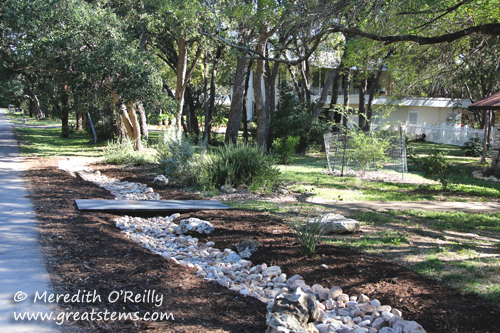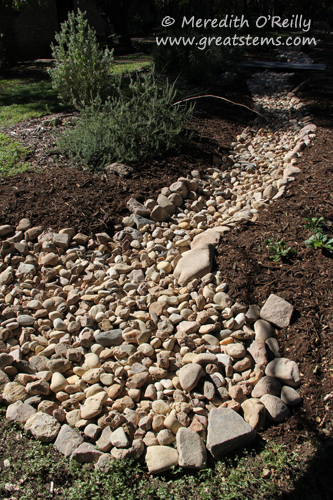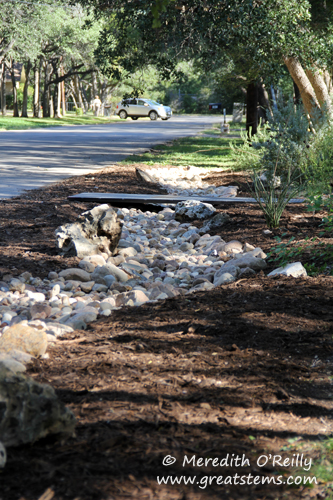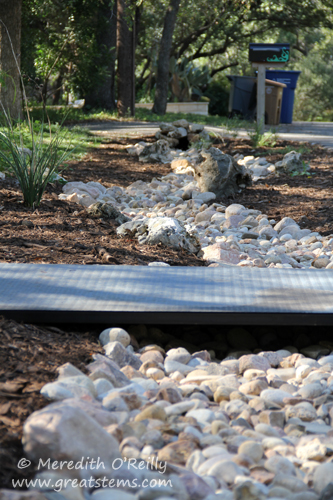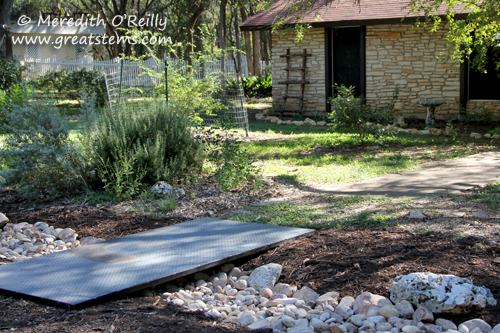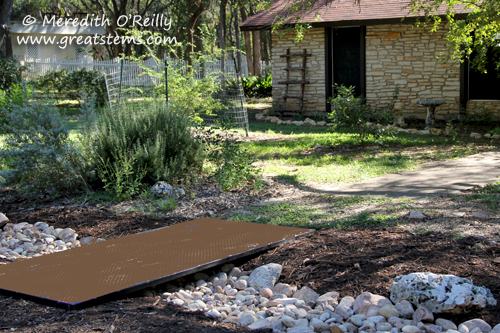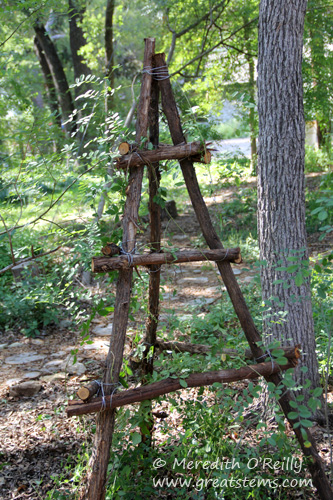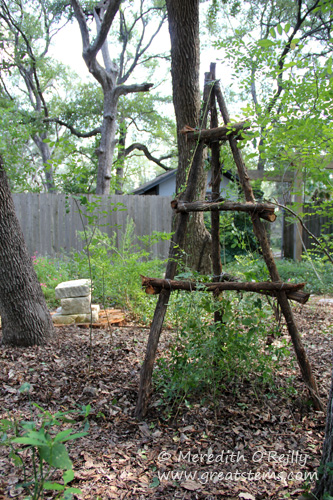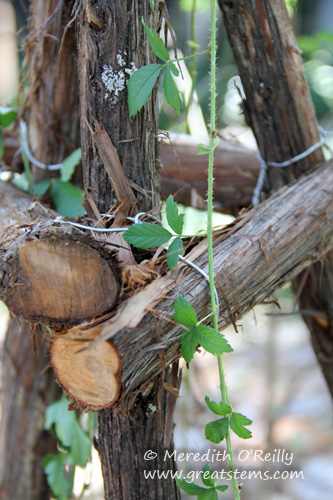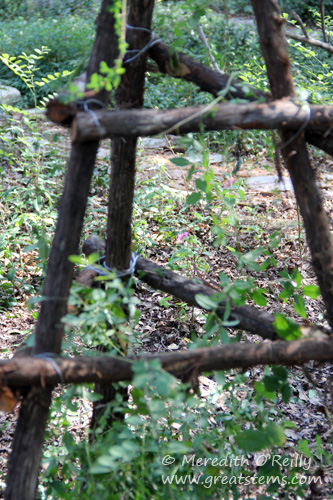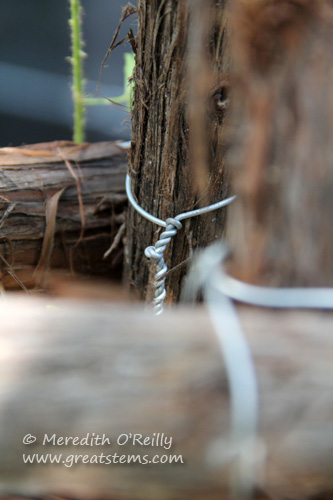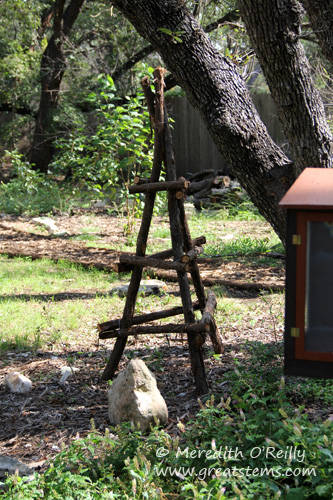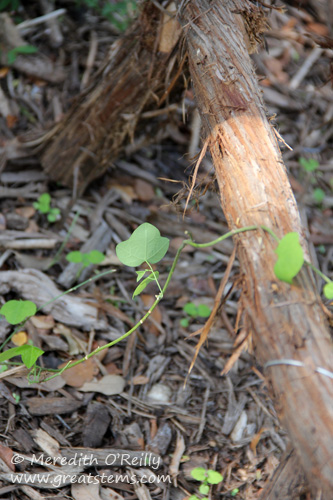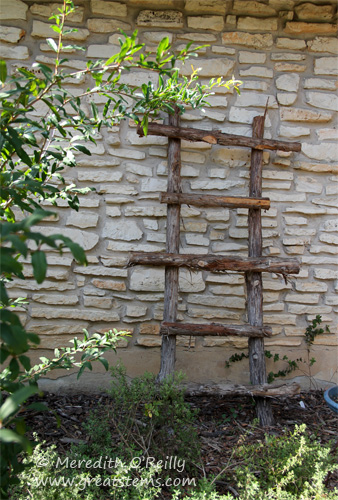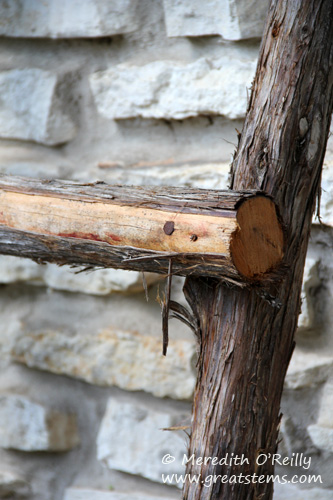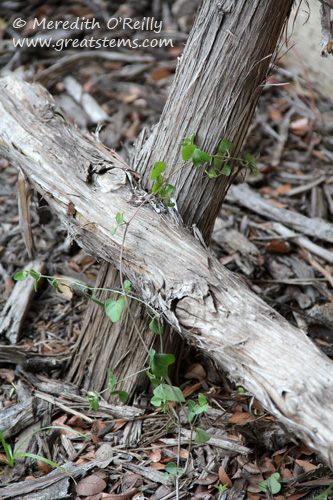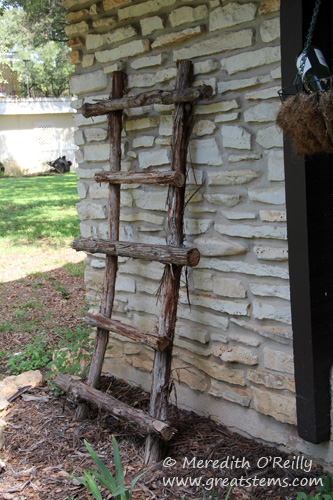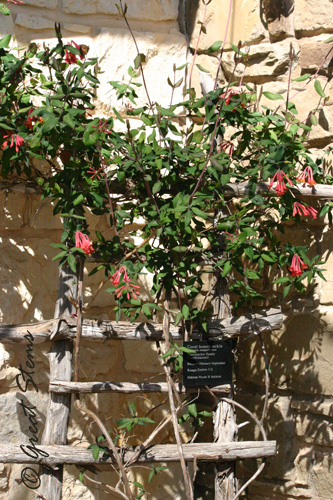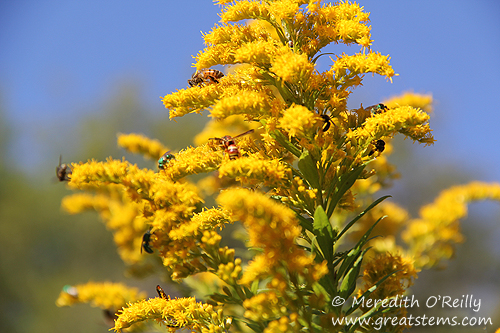
This fall, the Tall Goldenrod in my backyard reminds me once again why it deserves substantial recognition among native plants. Admittedly, it was planted by a bird in a less than convenient spot in my garden, but the rewards it offers pollinators make it a very valuable plant, and I most happily welcome it — even if it would look better against the fence rather than rising out of my shorter perennial butterfly garden like a giant, absurdly-placed monument. Well, I regularly talk about the importance of layers in nature — I shall simply embrace the layers nature brought to my butterfly garden. When I say Goldenrod, by the way, I mean that in a plural sense — I might have started with one, but I now have more, as is the nature of the plant.
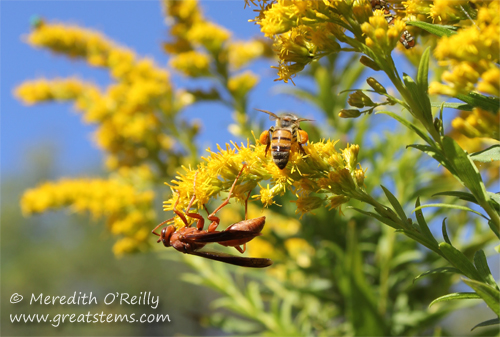
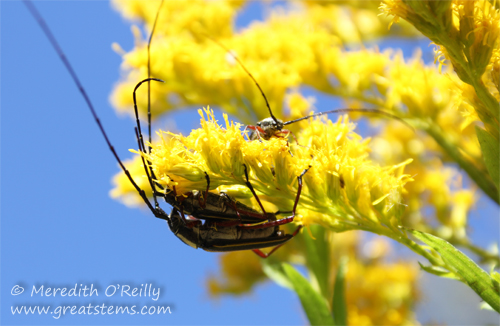
Double-banded Bycid pair mating (Longhorn beetles, Sphaenothecus bivittata)
(with an interested 3rd party above)
The vibrantly-colored Goldenrod is currently a source of high drama in my garden. Nectar and pollen banquets have brought pollinators by the hundreds, and along with lurking predators, insect mating, and numerous larvae moving about, there is a constant flurry of activity going on in and around the bright yellow blooms and tall stems. In terms of habitat, the Goldenrod seems to be representative of an entire ecosystem — nature is hard at work, with all its wonderful interactions between different animal species and with the Goldenrod plants themselves. The role of Goldenrod is vital, providing a nutritious food source for late-season insects and other animals.
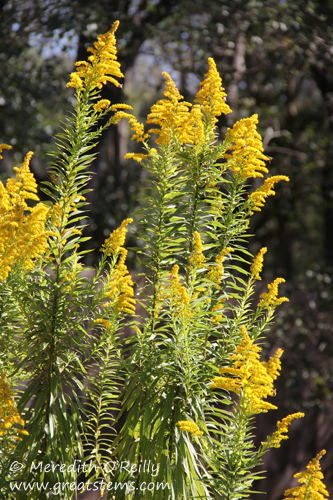
Goldenrods, or Solidago species, are members of the Aster family. Often similar in leaf and flower appearance, with natural variations in individual species to boot, the plants can be difficult to distinguish from each other. This causes great confusion for those trying to properly identify the species of the particular Goldenrods they encounter. For example, my Tall Goldenrod appears to be Solidago altissima, which some sources say is a subunit of Solidago canadensis, while others consider it to be a separate species. Yet another similar species is Solidago gigantea, or Giant Goldenrod. But for the plant in my garden, its narrow tri-veined leaves, pyramidal collections of tiny composite flowers, fine or absent serration on leaf edges, fine hairs on stems and leaves, and enormous height indicate that it is most likely altissima, but it all depends on the sources you agree with, because canadensis might be sufficient enough an ID. In any case, I appear to be growing what could be called Tall Goldenrod, Late Goldenrod, or Canada Goldenrod. What I do know is this: it’s a Goldenrod. Done.
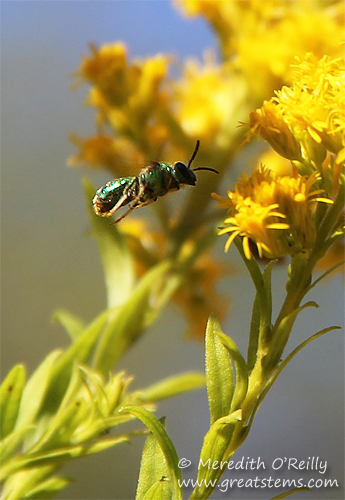
Metallic Green Sweat Bee, Augochloropsis metallica
Goldenrods’ normal habitats are fields and prairies, open woodlands, roadsides, ditches, rocky outcrops, disturbed areas, and waste areas. They often spread by rhizomes, creating colonies of clones, and this somewhat aggressive behavior is one reason some people consider Goldenrods weeds. There are species less prone to spreading, and those are perhaps better choices for smaller gardens. In my garden, my single plant has become a colony of about 12 clones, but what that means is that now I have 12 large, gorgeous bloom clusters to support wildlife. Goldenrods also can spread by seed, of course, which is how I ended up with a Goldenrod in my garden in the first place.
Goldenrods on occasion get another bad rap, unreasonably so. People suffering from hay fever sometimes wrongfully blame Goldenrods, which bloom about the same times as the wind-pollinated Ragweed, the true allergy-causing culprit. Goldenrod is mainly insect-pollinated, its pollen too heavy to be blown very far. Think of all those poor Goldenrods, mistakenly cut down when Ragweed was really to blame!
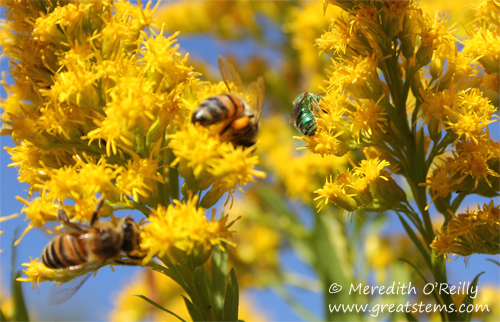 Goldenrods have high wildlife value. They are extremely important to pollinators, offering copious nectar and large, sticky pollen grains. At any point in the warmth of the day, I have hundreds of pollinators visiting the blooms. Standing up close to the flowers, I enjoy the movement of flying insects all around me, bees and wasps completely ignoring me as I turn blooms here and there for a picture or to study a particular insect. They just go about their business, eagerly moving from bloom to bloom to bloom. One cool morning, I even found three honeybees effectively frozen on the Goldenrod flowers, waiting to be warmed by the sun so they could begin to collect pollen again.
Goldenrods have high wildlife value. They are extremely important to pollinators, offering copious nectar and large, sticky pollen grains. At any point in the warmth of the day, I have hundreds of pollinators visiting the blooms. Standing up close to the flowers, I enjoy the movement of flying insects all around me, bees and wasps completely ignoring me as I turn blooms here and there for a picture or to study a particular insect. They just go about their business, eagerly moving from bloom to bloom to bloom. One cool morning, I even found three honeybees effectively frozen on the Goldenrod flowers, waiting to be warmed by the sun so they could begin to collect pollen again.
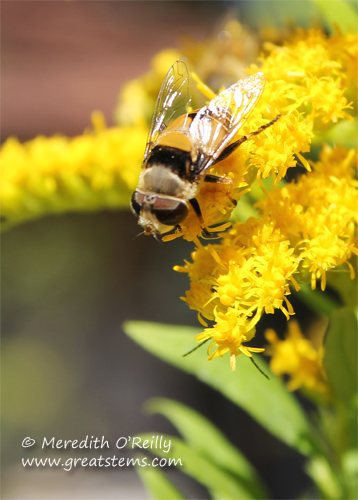
Syrphid fly
I can say confidently that the fragrant and bright Goldenrods have attracted the largest variety of insects of any plant in my wildlife garden. Multiple bee and wasp species, as well as a variety of flies, beetles, butterflies, and true bugs are attracted to the tantalizing blooms. In terms of numbers, the honeybees are the most plentiful, followed closely by numerous sweat bees, all gathering pollen and nectar. There are also many bee mimics, typically flies; their black and yellow coloration potentially help protect them from danger.
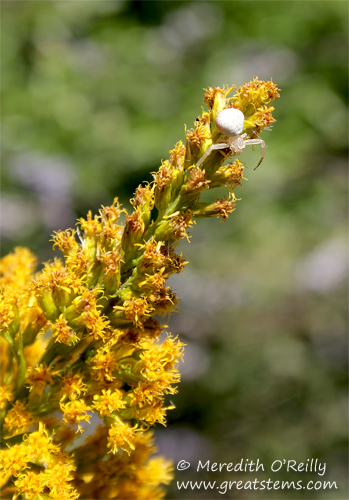
White Crab Spider
But where there are such numerous insects, beneficial predators are certain to follow, including spiders, dragonflies, birds, lady beetles and their larvae, and other natural population controllers. Many birds and mammals benefit directly from Goldenrods, as well. For example, Goldfinches and some sparrows eat Goldenrod seeds. Sometimes mammals, small and large, will eat the foliage, though it’s typically not a preferred food source for them.
Aside from the fun I’ve been having watching all the wildlife visiting my Goldenrods, there’s no denying that the bright yellow blooms provide a tremendously attractive pop of color to my garden. They love full sun and can tolerate part shade, and they like it neither too wet nor too dry. Blooms occur from late summer to fall, depending on the species. Often Goldenrods are paired with Fall Aster for a beautiful contrast of color. If there is a concern about potential spreading, transplant regularly and remove spent flowers before they go to seed. Otherwise, let your Goldenrod plants expand naturally if you have the space to allow them to do so — the pollinators will thank you for it!
Allow me to show off some more of the creatures that have been visiting my Goldenrods. Get ready for some yellow!
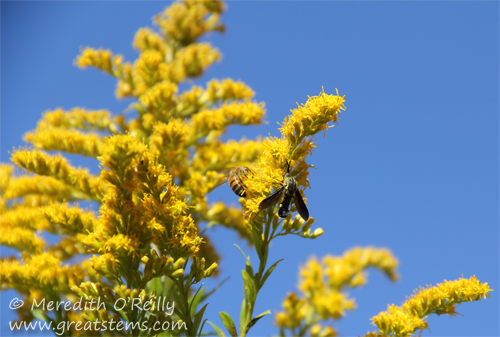
Scaly Bee Fly (Lepidophora lepidocera), with a Honeybee
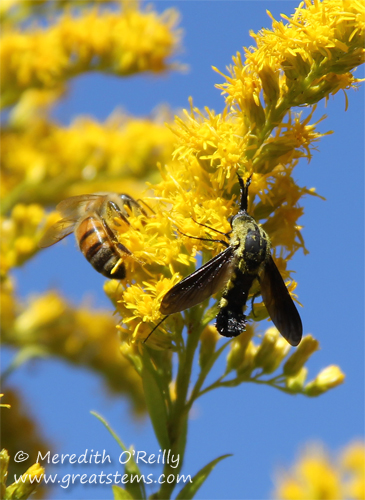
Close-up of the Scaly Bee Fly (Lepidophora lepidocera), with Honeybee.
Note the humped shape of the bee fly.
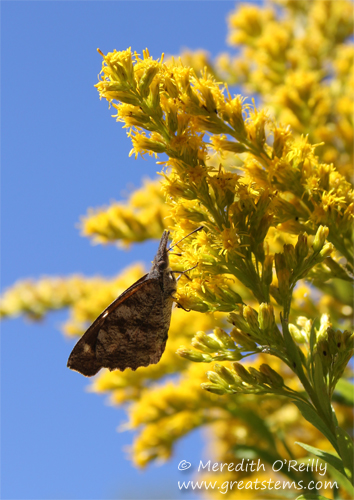
American Snout Butterfly
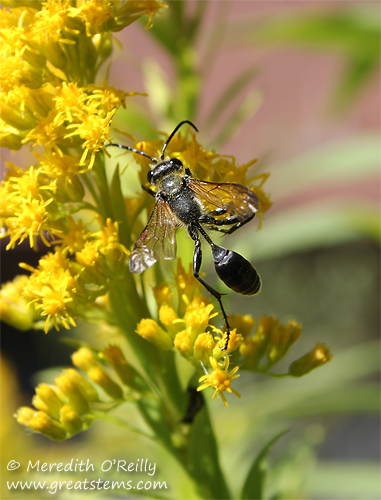
Thread-waisted solitary wasp
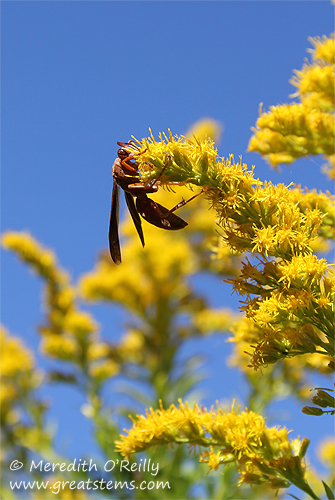
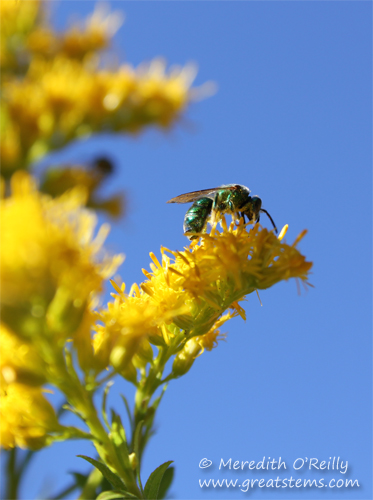
Metallic Green Sweat Bee, Augochloropsis metallica
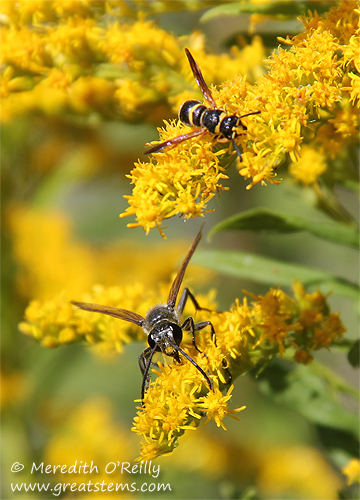
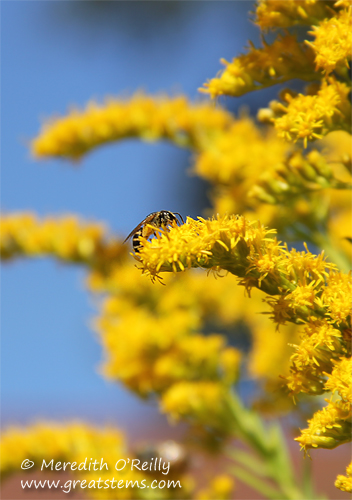
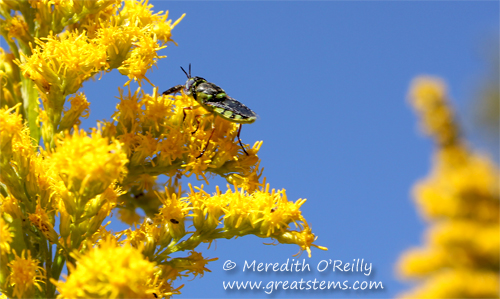
Soldier Fly, Odontomyia cincta
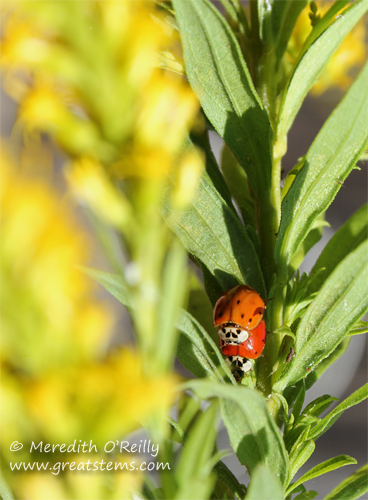 Lady beetles, mating
Lady beetles, mating
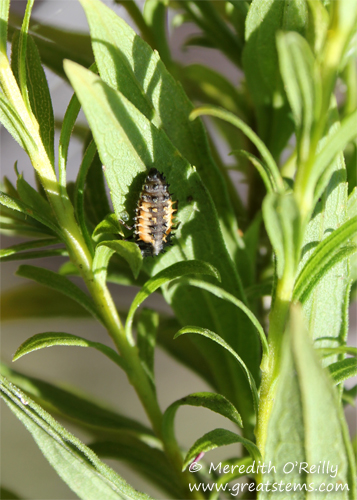
Ladybug larva
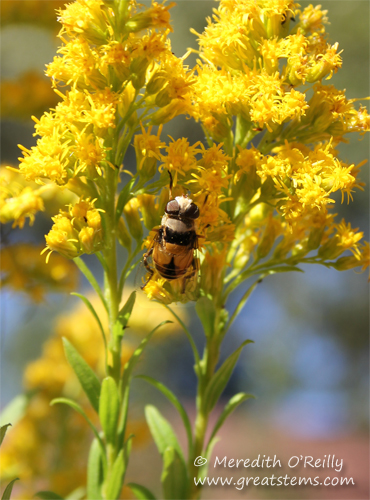
Syrphid fly
Just a sample of many!
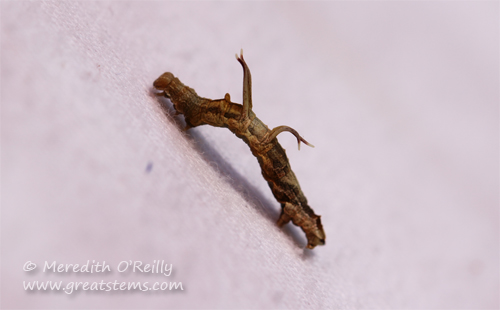
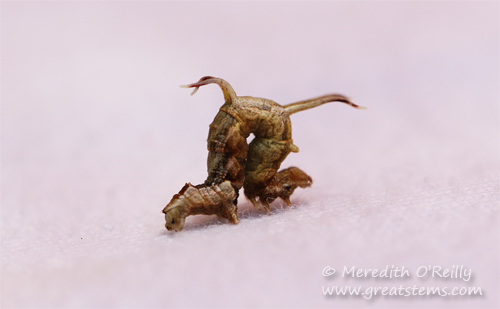 As near as I can tell, this inchworm is one of just a few species that have filaments — in the United States, there are primarily three recognized species. Ours appears to be Nematocampa resistaria, or Horned Spanworm Moth.
As near as I can tell, this inchworm is one of just a few species that have filaments — in the United States, there are primarily three recognized species. Ours appears to be Nematocampa resistaria, or Horned Spanworm Moth.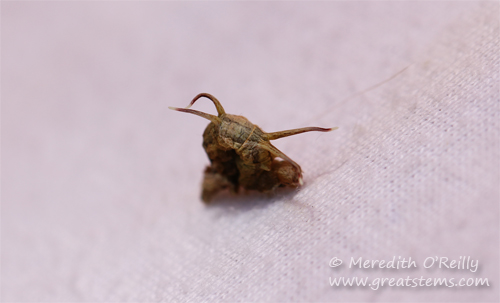
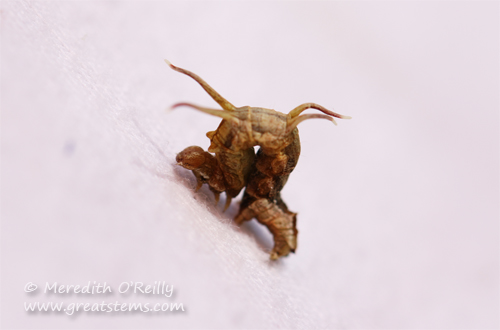 The length of the pale-tipped filaments on our little inchworm indicate that it was actually a little concerned by our presence (not that we were the ones invading its space this time, mind you — it was the other way around!). When relaxed, the inchworm’s filaments aren’t quite as long. When alarmed, it pumps hemolymph into them, which extends them — like spider legs, oooOOOoooh.
The length of the pale-tipped filaments on our little inchworm indicate that it was actually a little concerned by our presence (not that we were the ones invading its space this time, mind you — it was the other way around!). When relaxed, the inchworm’s filaments aren’t quite as long. When alarmed, it pumps hemolymph into them, which extends them — like spider legs, oooOOOoooh.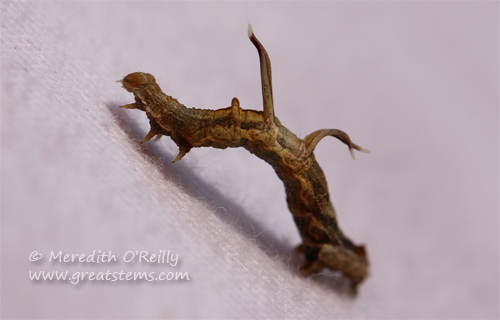 Remember, these little guys and other caterpillars have an important role in the ecosystem as food sources for birds and other animals — don’t squish them!
Remember, these little guys and other caterpillars have an important role in the ecosystem as food sources for birds and other animals — don’t squish them!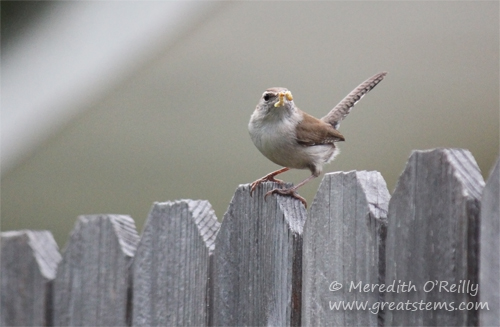
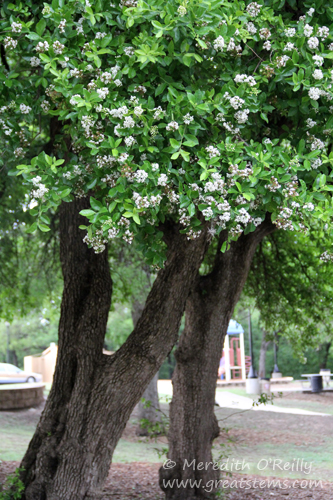
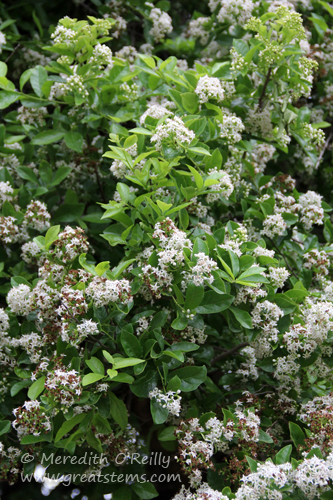
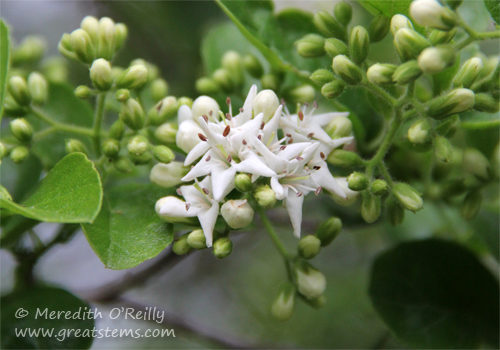
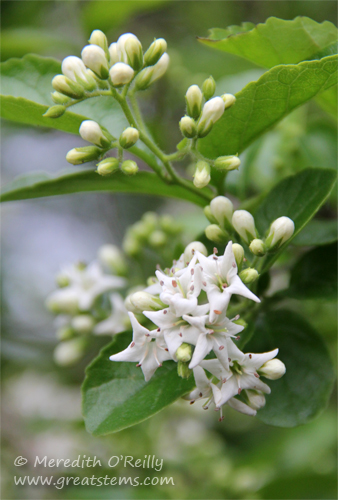
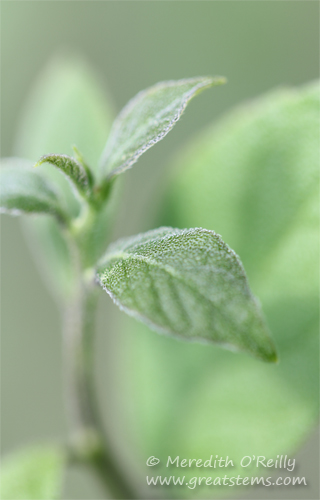
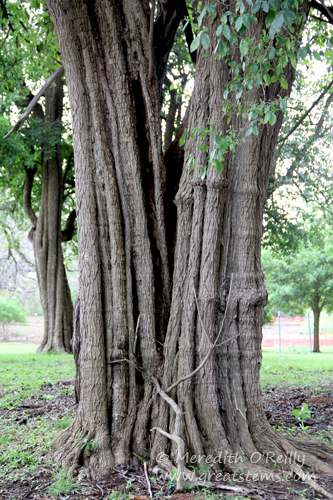
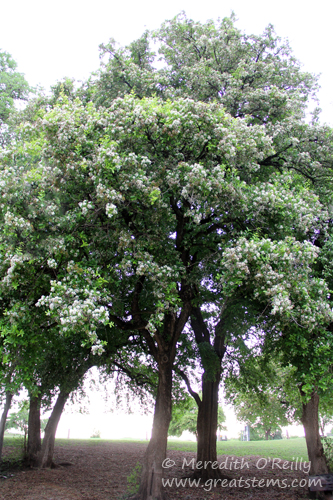
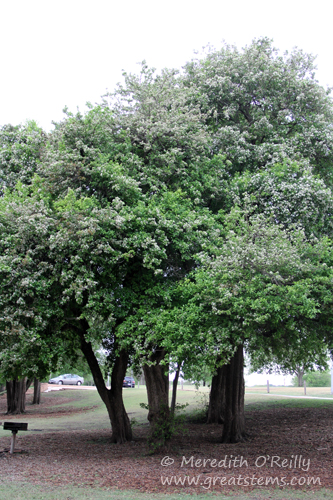
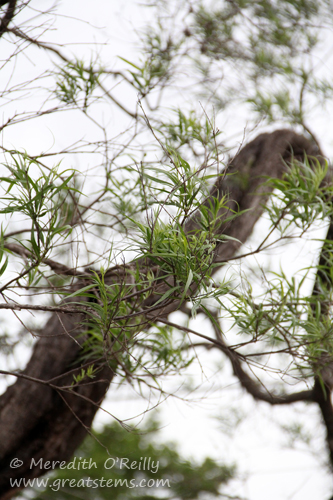
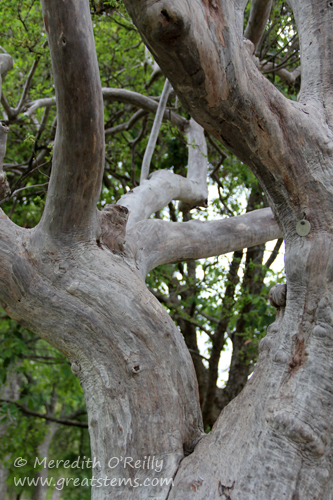
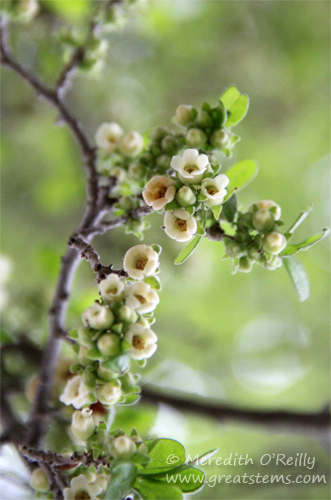
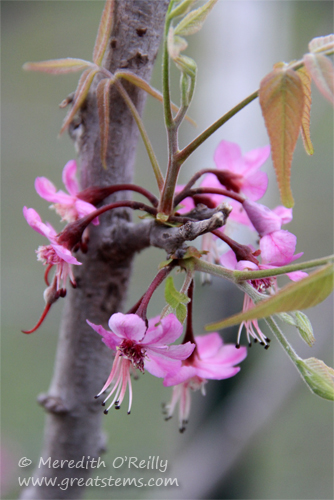
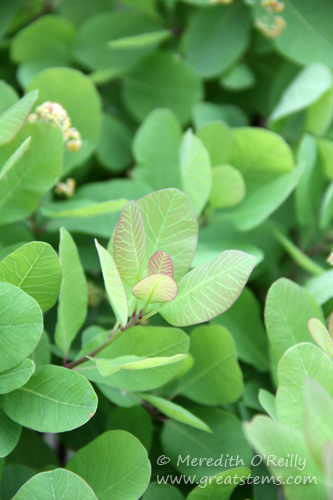 American Smoke Tree
American Smoke Tree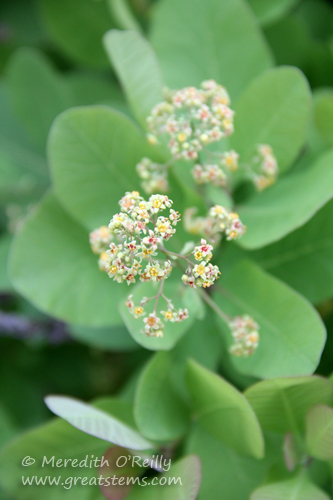
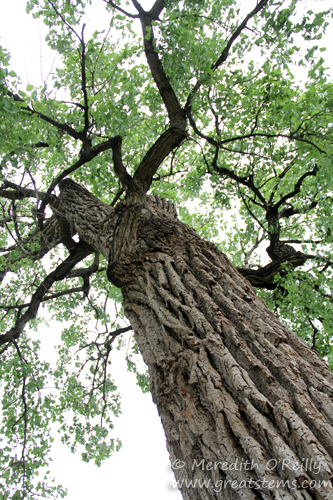
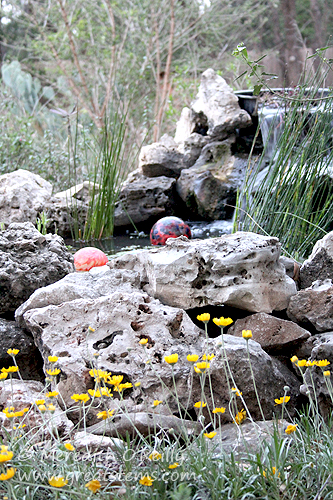
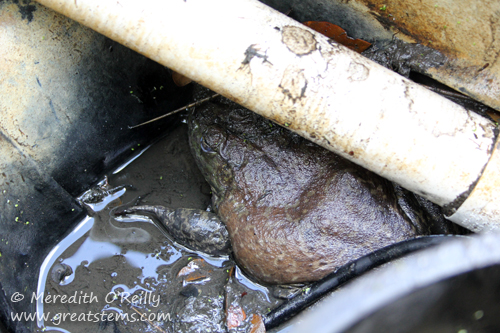 Eventually I got back to work, lowering the pond level more and rediscovering one of the frogs in the muck. Her belly, brown and rather alien-like, was what I noticed, and it’s what I gingerly had touched before when the frog ping-pong thing had happened. I wasn’t going to fall for it again. I KNEW that was the frog. What I did do was use the water to rinse enough of the muck away to at least find her head… and was that monstrous leg hers, too? Holy frog-moly, I thought. She’s huge.
Eventually I got back to work, lowering the pond level more and rediscovering one of the frogs in the muck. Her belly, brown and rather alien-like, was what I noticed, and it’s what I gingerly had touched before when the frog ping-pong thing had happened. I wasn’t going to fall for it again. I KNEW that was the frog. What I did do was use the water to rinse enough of the muck away to at least find her head… and was that monstrous leg hers, too? Holy frog-moly, I thought. She’s huge.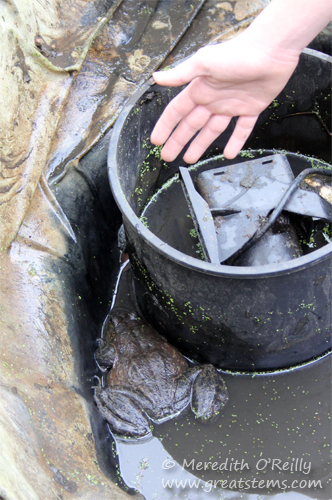
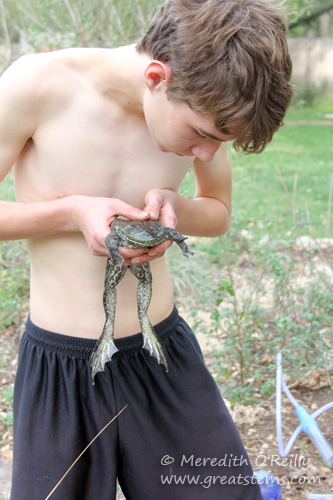
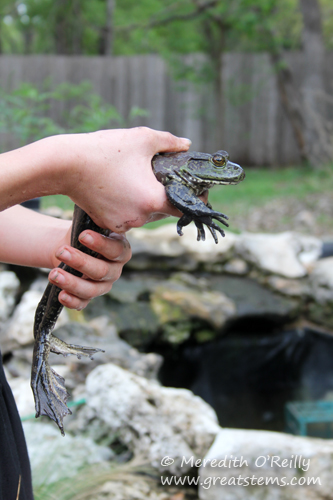
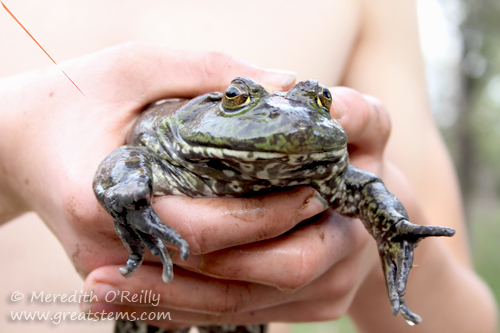 Even the beauty contests, perhaps, but only if the pond muck gets washed off first.
Even the beauty contests, perhaps, but only if the pond muck gets washed off first.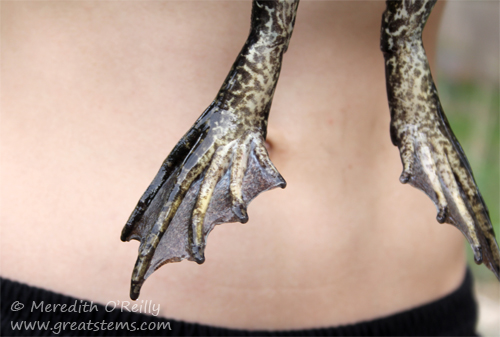
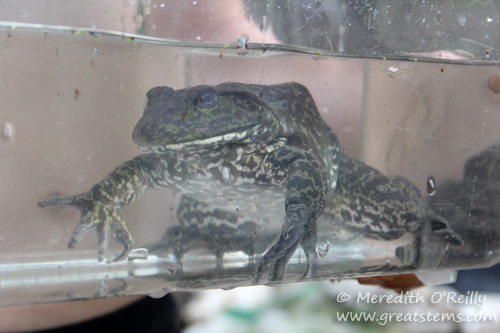
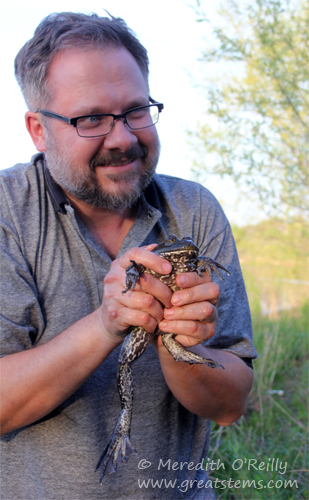
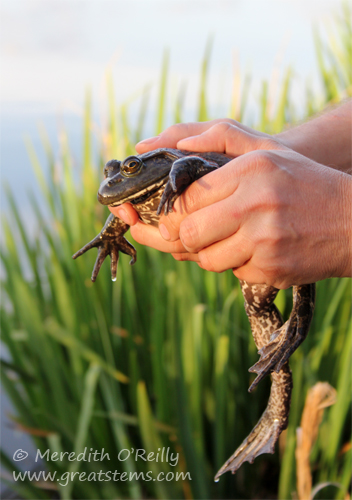
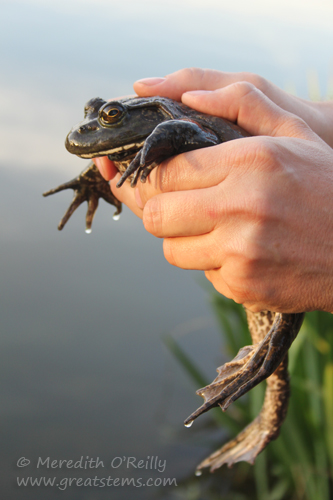
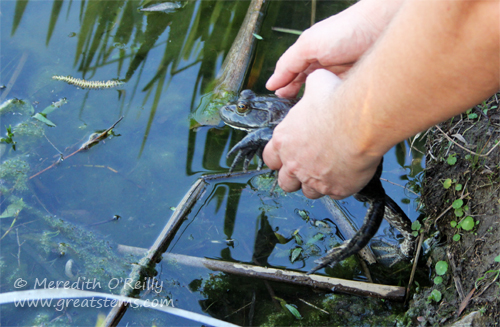
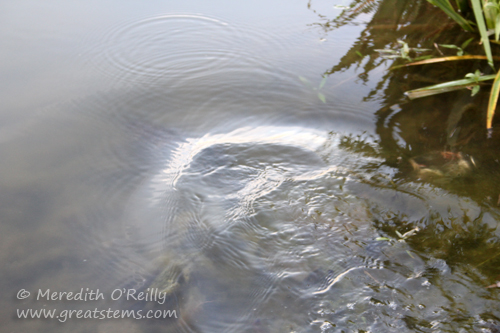 And there she went. I guess now she’ll be a small frog in a big pond, instead of the head honcho of a small pond, but somehow I think she’ll be happier. Our fish and birds will be happier, too.
And there she went. I guess now she’ll be a small frog in a big pond, instead of the head honcho of a small pond, but somehow I think she’ll be happier. Our fish and birds will be happier, too.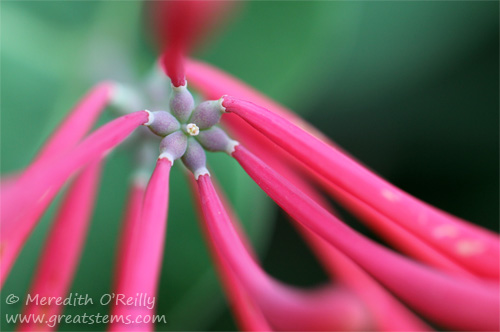
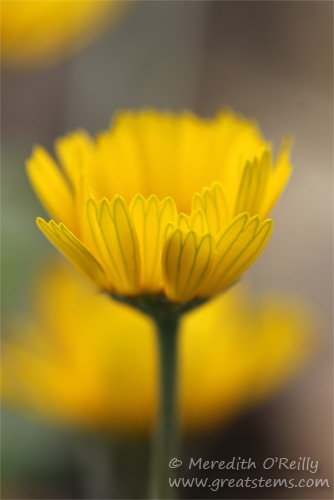
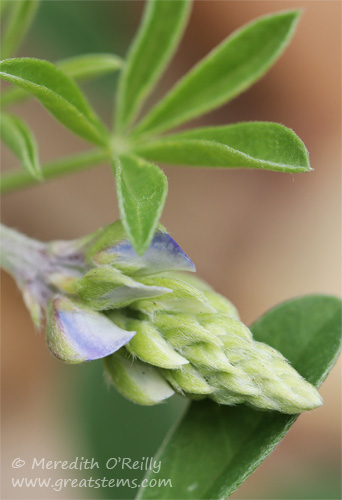
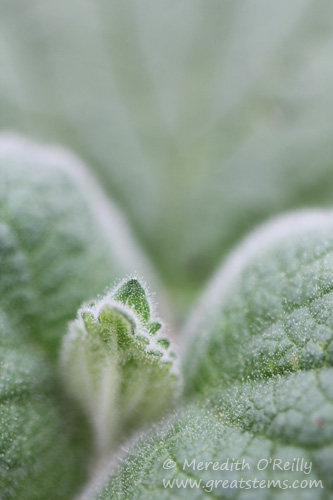
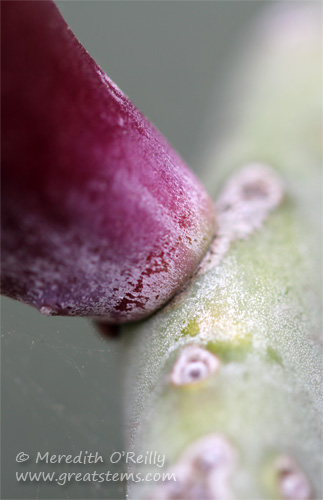
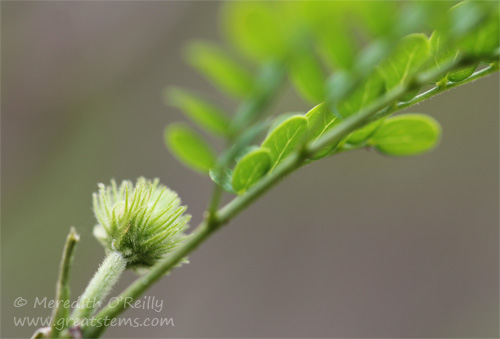
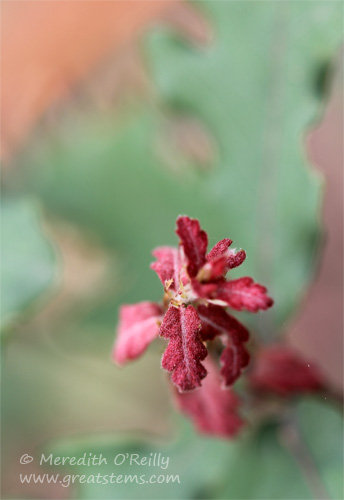
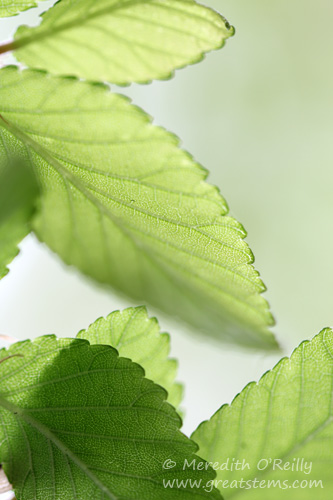
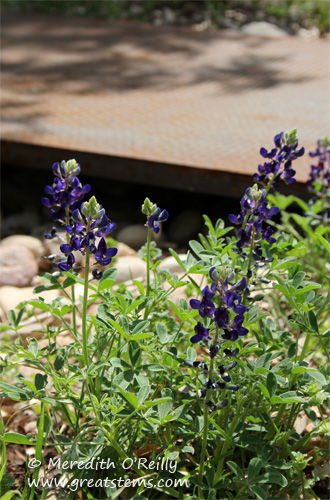 Out by the new
Out by the new 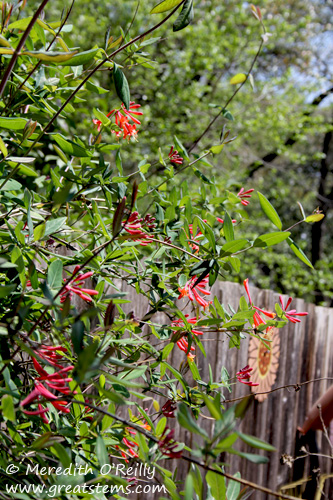 In the backyard, the Coral Honeysuckle is so dense and tall that I think this year it will finally spill over the fence.
In the backyard, the Coral Honeysuckle is so dense and tall that I think this year it will finally spill over the fence. 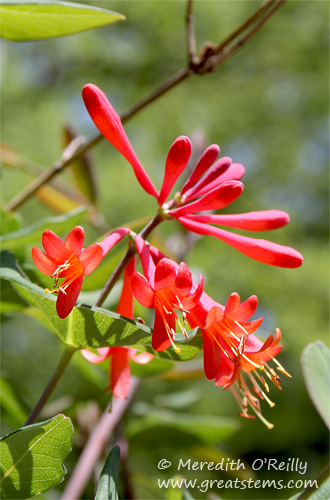 Hopefully my neighbor will enjoy the blooms — he loves color in the garden.
Hopefully my neighbor will enjoy the blooms — he loves color in the garden.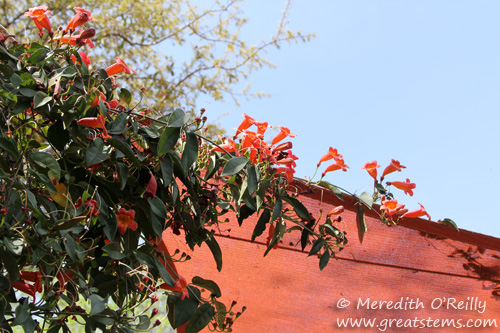 The Crossvine near the backyard shade sails is heavy with blooms (there were even more blooms a couple of days ago, but in typical fashion I forgot to put the memory card in the camera when I took pics that day — alas). We love the creeping vines and blooms working their way along the edge of the sails.
The Crossvine near the backyard shade sails is heavy with blooms (there were even more blooms a couple of days ago, but in typical fashion I forgot to put the memory card in the camera when I took pics that day — alas). We love the creeping vines and blooms working their way along the edge of the sails.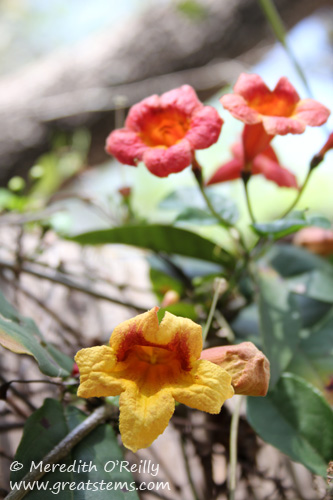 But here’s a mystery — over in the shade my original Crossvine plant, the native yellow-exterior variety, is doing something odd. Part of it is blooming yellow as expected, but the same plant is simultaneously producing orange-exterior blooms. What on earth is going on? There hasn’t been any change to the soil, but we did have a very mild winter — is it a temperature thing? I don’t want to lose my yellow blooms — they are my favorite! I’m trying not to feel alarmed, but I can’t help it!
But here’s a mystery — over in the shade my original Crossvine plant, the native yellow-exterior variety, is doing something odd. Part of it is blooming yellow as expected, but the same plant is simultaneously producing orange-exterior blooms. What on earth is going on? There hasn’t been any change to the soil, but we did have a very mild winter — is it a temperature thing? I don’t want to lose my yellow blooms — they are my favorite! I’m trying not to feel alarmed, but I can’t help it!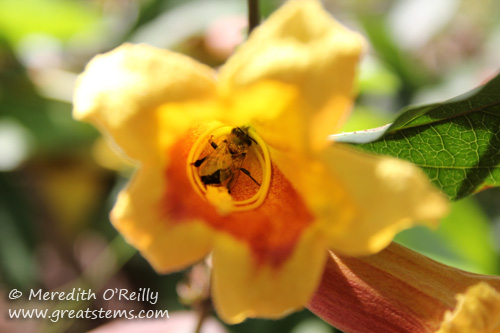 The honeybees don’t seem to mind the change — they visit the yellow and orange blooms with equal interest.
The honeybees don’t seem to mind the change — they visit the yellow and orange blooms with equal interest.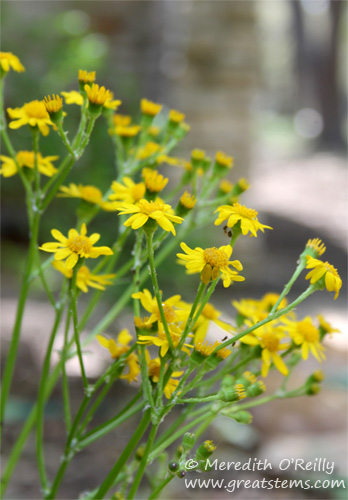 This year, I’m excited to see my Golden Groundsel blooming for the first time. Let’s hope it reseeds and makes babies.
This year, I’m excited to see my Golden Groundsel blooming for the first time. Let’s hope it reseeds and makes babies.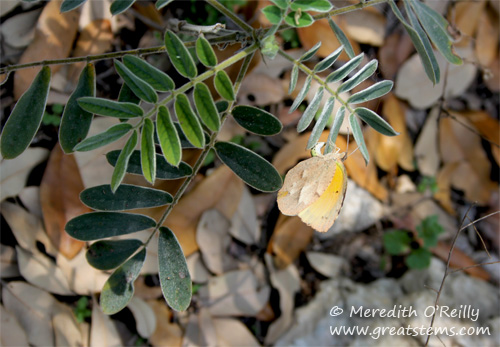 Sulphur butterflies, several species of them, have been busy laying eggs all over the Lindheimer’s Senna, which has barely had a chance to really show its spring face. But that’s par for the course — it’s the host plant for many Sulphur species, such as Sleepy Orange, Cloudless, Southern Dogface, Large Orange, and others. Eggs dot the tops and bottoms of the leaves — I can’t wait to see the caterpillars. I’m not worried about the number — I’ve got plenty of Lindheimer’s Senna to go around. I’ve never seen this many Sulphurs in the yard — can you guess how much I’m loving it? Lots!
Sulphur butterflies, several species of them, have been busy laying eggs all over the Lindheimer’s Senna, which has barely had a chance to really show its spring face. But that’s par for the course — it’s the host plant for many Sulphur species, such as Sleepy Orange, Cloudless, Southern Dogface, Large Orange, and others. Eggs dot the tops and bottoms of the leaves — I can’t wait to see the caterpillars. I’m not worried about the number — I’ve got plenty of Lindheimer’s Senna to go around. I’ve never seen this many Sulphurs in the yard — can you guess how much I’m loving it? Lots!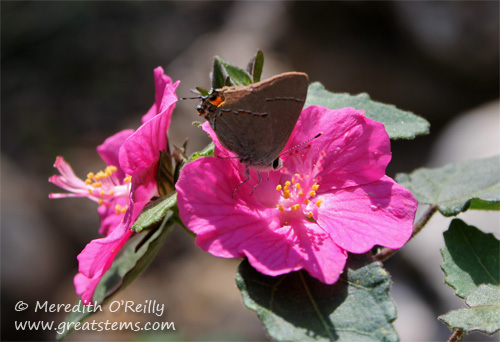 Gray Hairstreaks are visiting the garden, as well — this one on Rose Pavonia. Every time I see one, I think about how
Gray Hairstreaks are visiting the garden, as well — this one on Rose Pavonia. Every time I see one, I think about how 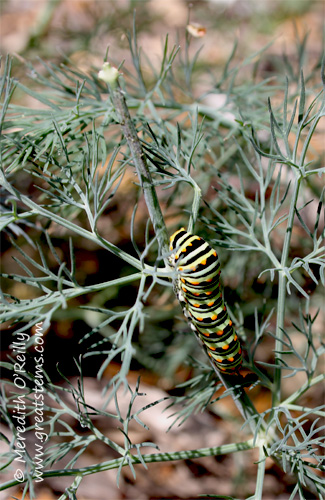 I was thrilled to discover that our dill and fennel are covered in Black Swallowtail caterpillars. In the fall I decided to be brave and plant the dill in one of the main garden beds, deciding that I’d be okay if it reseeds to abundance (the fennel is in its own container). Given my delight over the caterpillars, I feel confident that I made the right choice. But of course, we’ll see how much dill shows up next year!
I was thrilled to discover that our dill and fennel are covered in Black Swallowtail caterpillars. In the fall I decided to be brave and plant the dill in one of the main garden beds, deciding that I’d be okay if it reseeds to abundance (the fennel is in its own container). Given my delight over the caterpillars, I feel confident that I made the right choice. But of course, we’ll see how much dill shows up next year!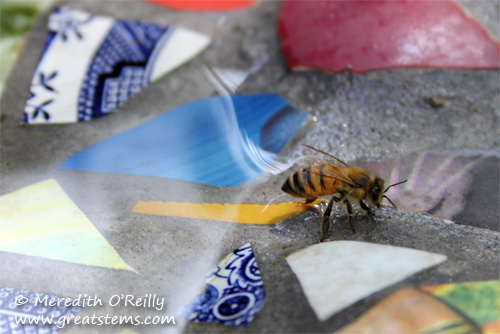 The mosaic birdbath is popular, and not just with birds. Squirrels and bees visit it, too — and who knows what else. It was fascinating watching the bees today — some collected water by skimming over the surface for a quick drink, but others preferred to stand on the side and drink safely at their leisure.
The mosaic birdbath is popular, and not just with birds. Squirrels and bees visit it, too — and who knows what else. It was fascinating watching the bees today — some collected water by skimming over the surface for a quick drink, but others preferred to stand on the side and drink safely at their leisure.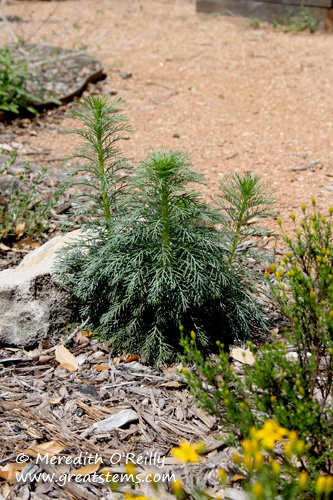 I’ve got many Standing Cypress plants now in their second year, and the flower spikes are already on their way up. They will grow big and tall by the time they are ready to show their vibrant red flowers — which the hummingbirds will go crazy for!
I’ve got many Standing Cypress plants now in their second year, and the flower spikes are already on their way up. They will grow big and tall by the time they are ready to show their vibrant red flowers — which the hummingbirds will go crazy for!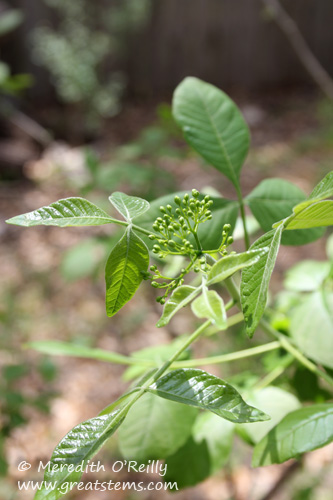 The Wafer Ash is even closer to blooming. With luck, I’ll actually see the flowers this year (usually they are sneaky, and the blooms come and go before I notice).
The Wafer Ash is even closer to blooming. With luck, I’ll actually see the flowers this year (usually they are sneaky, and the blooms come and go before I notice).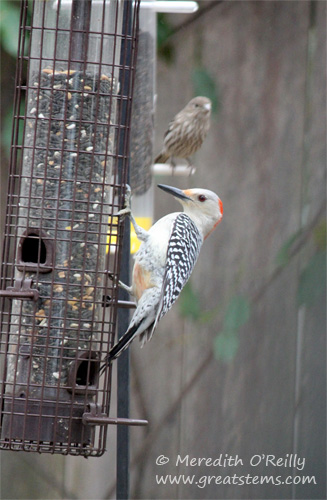
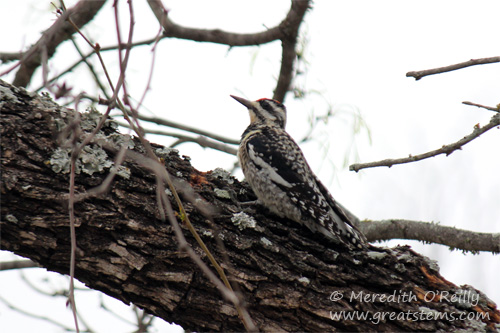
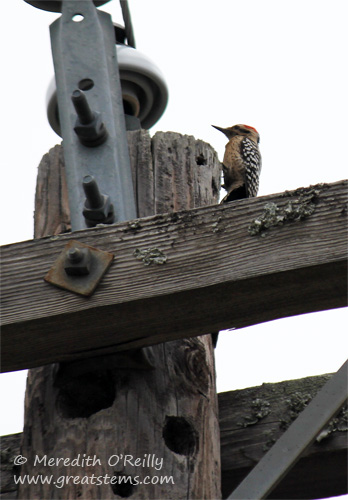
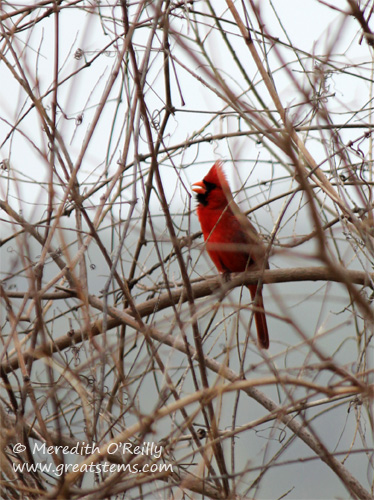 Not to be ignored, this Northern Cardinal was singing his heart out. He and a few other male cardinals were quite feisty today. Gee, does nesting season approach?
Not to be ignored, this Northern Cardinal was singing his heart out. He and a few other male cardinals were quite feisty today. Gee, does nesting season approach?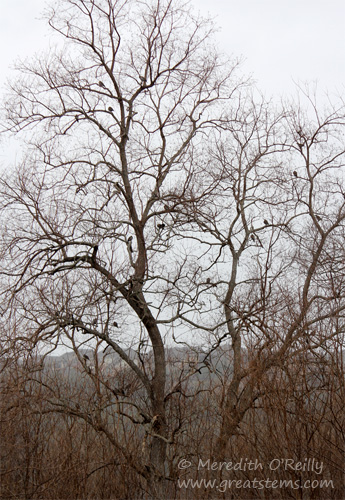
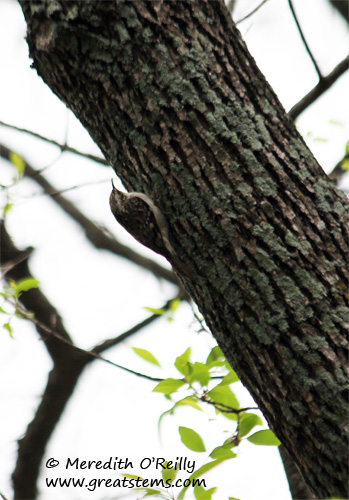
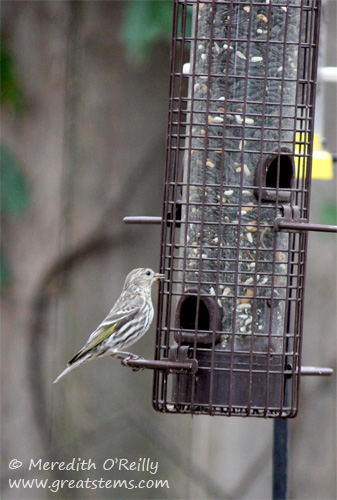
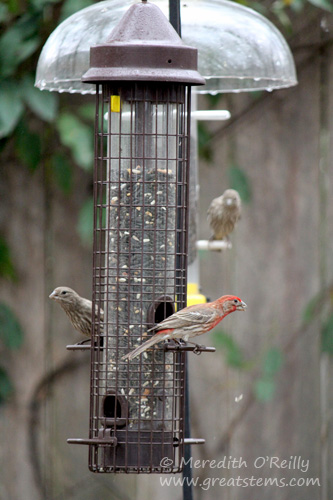





 Goldenrods have high wildlife value. They are extremely important to pollinators, offering copious nectar and large, sticky pollen grains. At any point in the warmth of the day, I have hundreds of pollinators visiting the blooms. Standing up close to the flowers, I enjoy the movement of flying insects all around me, bees and wasps completely ignoring me as I turn blooms here and there for a picture or to study a particular insect. They just go about their business, eagerly moving from bloom to bloom to bloom. One cool morning, I even found three honeybees effectively frozen on the Goldenrod flowers, waiting to be warmed by the sun so they could begin to collect pollen again.
Goldenrods have high wildlife value. They are extremely important to pollinators, offering copious nectar and large, sticky pollen grains. At any point in the warmth of the day, I have hundreds of pollinators visiting the blooms. Standing up close to the flowers, I enjoy the movement of flying insects all around me, bees and wasps completely ignoring me as I turn blooms here and there for a picture or to study a particular insect. They just go about their business, eagerly moving from bloom to bloom to bloom. One cool morning, I even found three honeybees effectively frozen on the Goldenrod flowers, waiting to be warmed by the sun so they could begin to collect pollen again.










 Lady beetles, mating
Lady beetles, mating

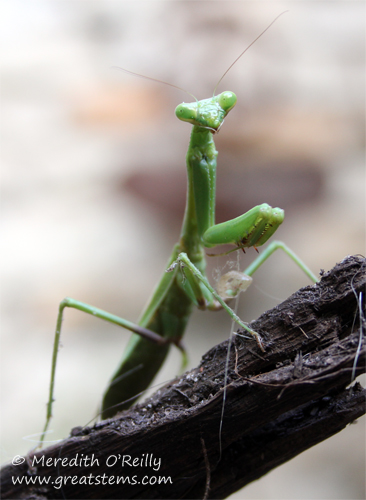 Praying Mantises are notorious for being fierce predators — cannibalistic ones at that. Beware the nearby sibling or mate — it might become a fast snack. If you are in the mood for horror this Halloween, explore the many
Praying Mantises are notorious for being fierce predators — cannibalistic ones at that. Beware the nearby sibling or mate — it might become a fast snack. If you are in the mood for horror this Halloween, explore the many 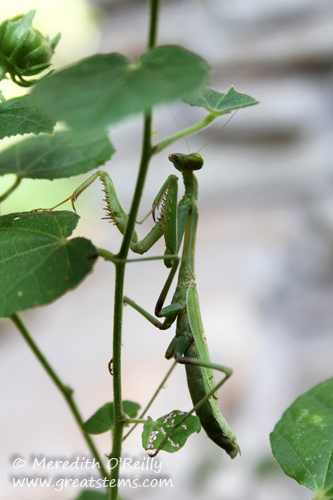 Praying Mantises really should be as iconic as pumpkins, spiders, zombies, and ghosts when it comes to Halloween. They are fast and sneaky and downright horrific in their voraciousness, the way they pierce and decapitate their prey and gnaw on body parts. And FYI, I draw the line at letting one near my hummingbird feeders.
Praying Mantises really should be as iconic as pumpkins, spiders, zombies, and ghosts when it comes to Halloween. They are fast and sneaky and downright horrific in their voraciousness, the way they pierce and decapitate their prey and gnaw on body parts. And FYI, I draw the line at letting one near my hummingbird feeders. Here’s another predator, this one in our family. Much like a Praying Mantis, he eats everything, though unlike the insect version, he has yet to eat his sibling. In this photo he’s about to bravely enter a zombie fallout zone…
Here’s another predator, this one in our family. Much like a Praying Mantis, he eats everything, though unlike the insect version, he has yet to eat his sibling. In this photo he’s about to bravely enter a zombie fallout zone…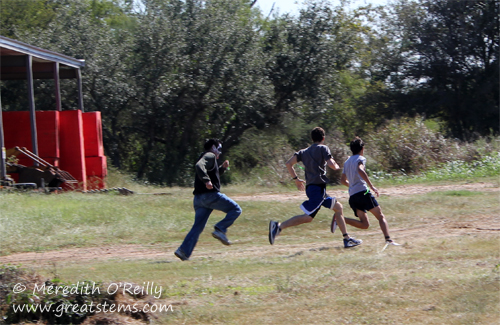 where lurking zombies chased him over haystacks, through mud pits, and across ponds as he ran for his life. Thankfully he did not become a zombie himself, arriving to safety with life intact. Good thing he was well fueled ahead of time, eating as much as he does.
where lurking zombies chased him over haystacks, through mud pits, and across ponds as he ran for his life. Thankfully he did not become a zombie himself, arriving to safety with life intact. Good thing he was well fueled ahead of time, eating as much as he does.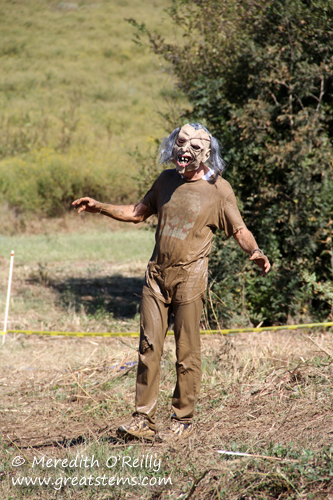 Zombies, as you know, will accept a variety of body parts, but they show a particular preference for brains. Point being, my son eats everything, but Zombies don’t.
Zombies, as you know, will accept a variety of body parts, but they show a particular preference for brains. Point being, my son eats everything, but Zombies don’t.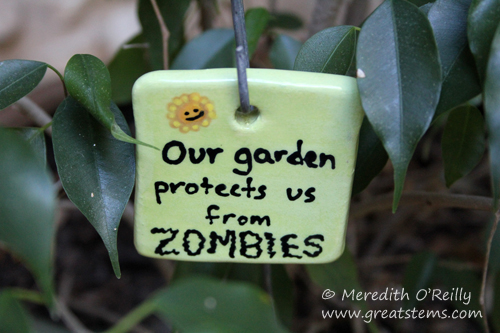 Here at home, our garden protects us from Zombies, and we have a sign to prove it. But every once in a while a Zombie might sneak past….
Here at home, our garden protects us from Zombies, and we have a sign to prove it. But every once in a while a Zombie might sneak past….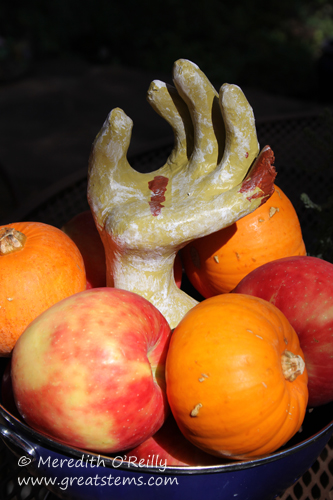
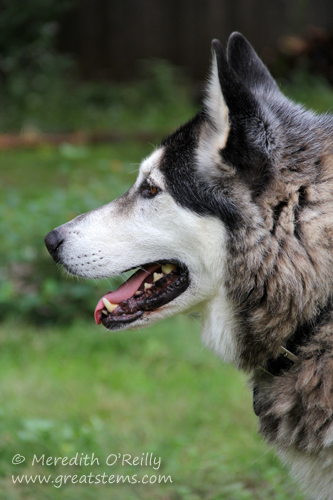 This is the predator who ate the finger off the Zombie hand that lurked in our fruit bowl. Now it’s even more of a Zombie hand.
This is the predator who ate the finger off the Zombie hand that lurked in our fruit bowl. Now it’s even more of a Zombie hand.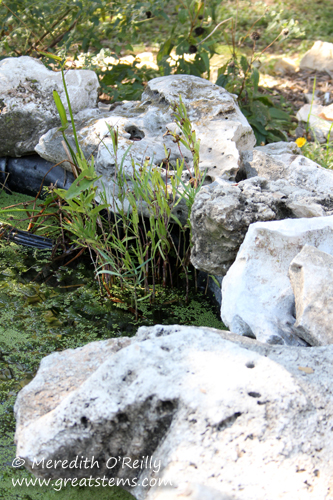 In this pond lurks the Unknown Predator, the creature that ducks just out of sight every time I try to catch a glimpse, no matter how stealthily I approach. It just rustles plants to show me it’s there, flaunting the fact that it is sneakier than I am. It’s not the Creature from the Black Lagoon, though — I retain
In this pond lurks the Unknown Predator, the creature that ducks just out of sight every time I try to catch a glimpse, no matter how stealthily I approach. It just rustles plants to show me it’s there, flaunting the fact that it is sneakier than I am. It’s not the Creature from the Black Lagoon, though — I retain 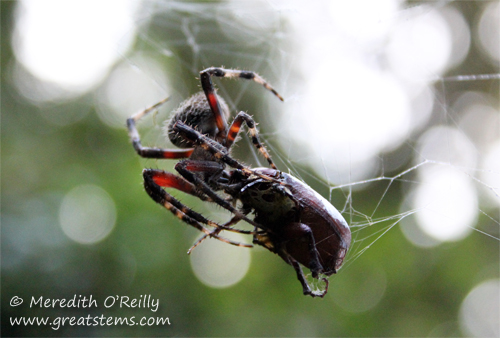
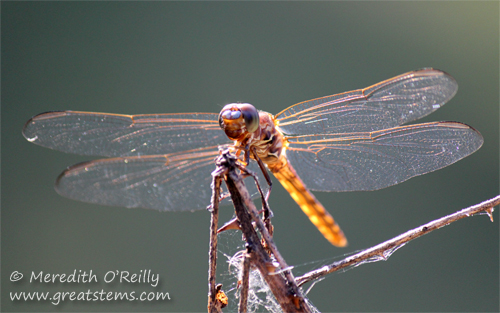
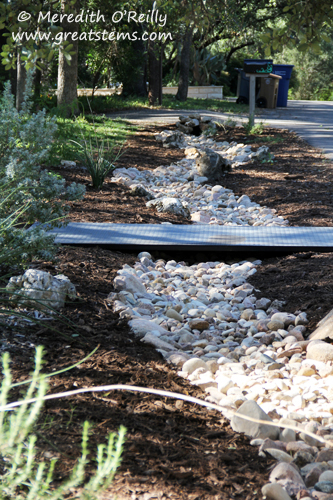 For years, a very functional but unattractive trench in the front yard has protected our house from flooding, as we are slightly downhill from our neighbors across the street and to our left. Water didn’t really flow along this trench; the ditch merely served as a catch spot for excess rainwater (if we ever got rain), until the ground could absorb it all.
For years, a very functional but unattractive trench in the front yard has protected our house from flooding, as we are slightly downhill from our neighbors across the street and to our left. Water didn’t really flow along this trench; the ditch merely served as a catch spot for excess rainwater (if we ever got rain), until the ground could absorb it all.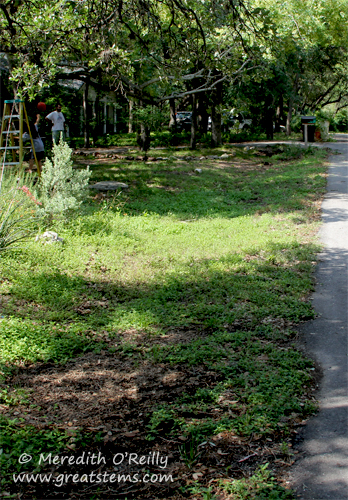 However, this trench hindered gardening and was very boring and ugly to look at. Additionally, it was slowly accumulating dirt from other yards, as well as assorted grasses and weeds, and bit by bit it was filling in. Without a little repair, eventually there might not have been much of a trench to hold the water back. So in order to give this trench both beauty and improved function, I decided to turn it into a dry creek bed.
However, this trench hindered gardening and was very boring and ugly to look at. Additionally, it was slowly accumulating dirt from other yards, as well as assorted grasses and weeds, and bit by bit it was filling in. Without a little repair, eventually there might not have been much of a trench to hold the water back. So in order to give this trench both beauty and improved function, I decided to turn it into a dry creek bed.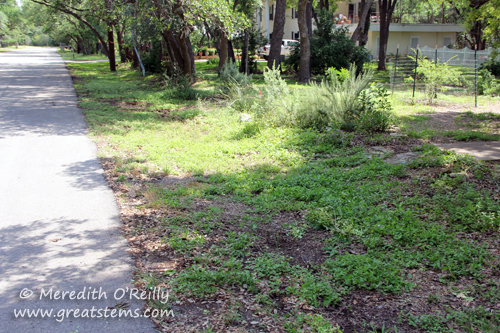
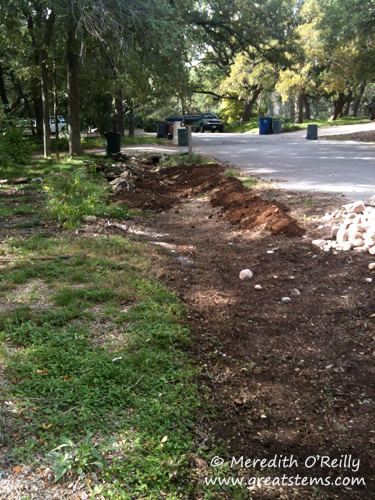 First, we dug out the weeds and cleared the area. Next, I sprinkled flour onto the ground to visually create the desired curves of the future creek bed (a great use, by the way, for leftover wheat-based flour after you’ve gone gluten-free; plus it’s cheap and environmentally friendly). Following the creek “flour,” we dug down 1-2 extra inches, creating a trench more effective than its predecessor. We piled the soil to the side to create the bank sides, and we supplemented the banks with extra soil from a pile I have in the backyard.
First, we dug out the weeds and cleared the area. Next, I sprinkled flour onto the ground to visually create the desired curves of the future creek bed (a great use, by the way, for leftover wheat-based flour after you’ve gone gluten-free; plus it’s cheap and environmentally friendly). Following the creek “flour,” we dug down 1-2 extra inches, creating a trench more effective than its predecessor. We piled the soil to the side to create the bank sides, and we supplemented the banks with extra soil from a pile I have in the backyard.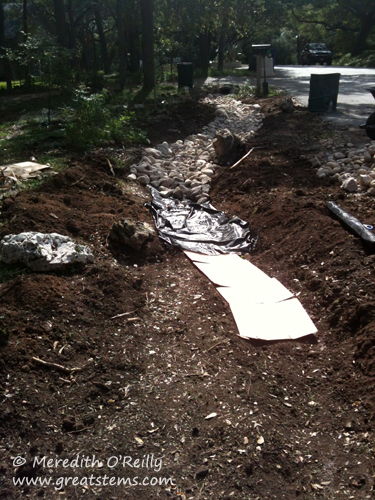 As we went along, I laid down a combination of cardboard, newspaper, and a very light-weight water-penetrating weed barrier, something that will break down easily and will let water seep through. This was the first time I ever, ever, ever considered a non-paper weed barrier, and it was only because I needed the creek to resist weeds for a longer time than the cardboard and newspaper, which decompose quickly with moisture, would provide. I am, for the record, not a fan of plastic weed barriers. This super-thin one was selected because it would easily fall apart. Otherwise, I would have only used the cardboard and newspaper. Don’t ask me the brand I used — the wrapper disappeared sometime last May when we first started this project. Also, I cut the weed barrier into small 3’x3′ sections — this means that if I ever have to remove any part of it, it will be easy to do so.
As we went along, I laid down a combination of cardboard, newspaper, and a very light-weight water-penetrating weed barrier, something that will break down easily and will let water seep through. This was the first time I ever, ever, ever considered a non-paper weed barrier, and it was only because I needed the creek to resist weeds for a longer time than the cardboard and newspaper, which decompose quickly with moisture, would provide. I am, for the record, not a fan of plastic weed barriers. This super-thin one was selected because it would easily fall apart. Otherwise, I would have only used the cardboard and newspaper. Don’t ask me the brand I used — the wrapper disappeared sometime last May when we first started this project. Also, I cut the weed barrier into small 3’x3′ sections — this means that if I ever have to remove any part of it, it will be easy to do so.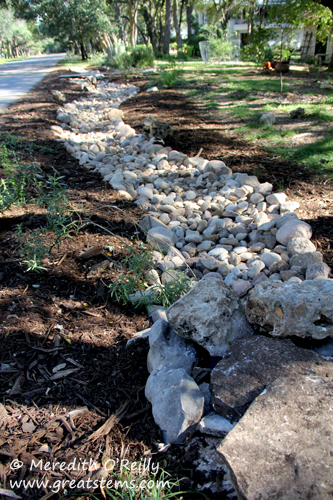 From there, it was just a matter of placing the rocks. I selected rocks from an area fairly close to home — Llano. The rocks range in size from 2″ to 10″ — the smaller ones are in the center of the creek, while the larger ones line the edges. I wanted larger rock rather than tiny stuff that would become a maintenance nightmare. Have you seen how many people want others to come and scrape out and remove their tiny rock and gravel that’s become filled with dirt and leaves? No, thank you.
From there, it was just a matter of placing the rocks. I selected rocks from an area fairly close to home — Llano. The rocks range in size from 2″ to 10″ — the smaller ones are in the center of the creek, while the larger ones line the edges. I wanted larger rock rather than tiny stuff that would become a maintenance nightmare. Have you seen how many people want others to come and scrape out and remove their tiny rock and gravel that’s become filled with dirt and leaves? No, thank you.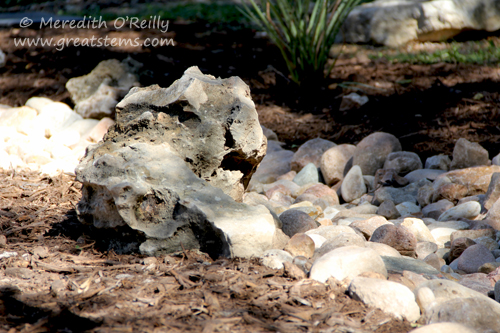 From the backyard, we pulled a few limestone boulders to place here and there. We placed these as we were still moving soil around so they’d be held in place, good and solid.
From the backyard, we pulled a few limestone boulders to place here and there. We placed these as we were still moving soil around so they’d be held in place, good and solid.